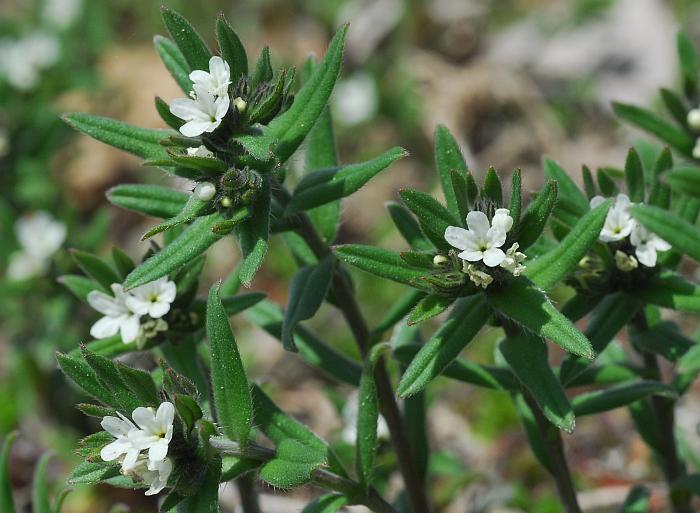Buglossoides arvensis (L.) I.M. Johnst.
Corn Gromwell

Introduced
CC = *
CW = 5
MOC = 65
© SRTurner
Buglossoides arvensis (L.) I.M. Johnst.Corn Gromwell | |
 |
Introduced CC = * CW = 5 MOC = 65 |
© SRTurner |
|
Family - Boraginaceae Habit - Taprooted annual forb. Stems - Ascending to erect, to 50 cm, solitary, often branched, densely pubescent with short, appressed, antrorse, pustular-based hairs.
Leaves - Alternate, and basal, with basal leaves often withered at flowering. Stem leaves sessile or short-petiolate, to 7 cm long and 8 mm wide, linear-oblong to lanceolate, densely appressed-pubescent on both surfaces, with prominent midrib below, simple, entire (margins sometimes revolute), usually acute, apex often curved.
Inflorescence - Solitary flowers in upper leaf axils, sometimes appearing as leafy, spikelike racemes. Flowers on stalks to 1.5 mm long.
Flowers - Calyces actinomorphic, 5-lobed nearly to the base, the lobes 6-8 mm long at flowering, becoming elongated to 8-13 mm at fruiting, linear to narrowly triangular, densely appressed-hairy, persistent and ascending at fruiting. Corollas 5-8 mm long, narrowly funnelform, 5-lobed, actinomorphic, white, the tube 4-6 mm long, exceeding or equaling calyx, the throat lacking scales but with 5 lines or bands of minute glandular hairs extending into the tube, the lobes 1.0-1.5 mm long, more or less ascending, rounded to bluntly pointed. Stamens 5, alternating with corolla lobes, attached near the base of the corolla tube, the filaments short (0.1 mm), the anthers yellow and oblong, positioned near the tube midpoint, not exserted from the corolla. Ovary deeply 4-lobed, the style short, not exserted from the corolla, often not persistent at fruiting, the stigma capitate, 2-lobed.
Fruits - Schizocarps dividing into mostly 4 nutlets, these 2.5-3.5 mm long, hard and dense, erect to slightly oblique, angular-ovoid with a blunt ventral keel, attached to the relatively flat gynobase at the base or nearly so, the attachment scar surrounded by a low, collarlike ring, bluntly pointed at the tip, the surface strongly longitudinally wrinkled and pitted, tan to grayish brown with darker depressions.
Flowering - April - June. Habitat - Open disturbed ground, fields, roadsides, railroads. Origin - Native to Europe. Lookalikes - Myosotis spp. Other info. - This little plant is quite well established and probably occurs on disturbed ground in most if not all of the state. It is also found in much of the U.S. and Canada, though is rare or absent in some Plains, Mountain, and southwestern states. If left alone the plant get get taller and form fairly large colonies. This is an easy species to identify because of its appressed pubescent stems, small white flowers, and weedy habit. In contrast to Myosotis species, the fruiting calyces of Buglossoides are obscured by leaves or bracts, and also lack hooked hairs. Photographs taken in Brown Summit, NC., 4-5-03, and in Smith Station, AL., 2-25-06 (DETenaglia); also near St. Albans, Franklin County, MO, 3-13-2012, near Marthasville, Warren County, MO, 4-1-2019, near Labadie, Franklin County, MO, 4-28-2019, and along the Katy Trail near Dutzow, Warren County, MO, 4-20-2020 (SRTurner). |